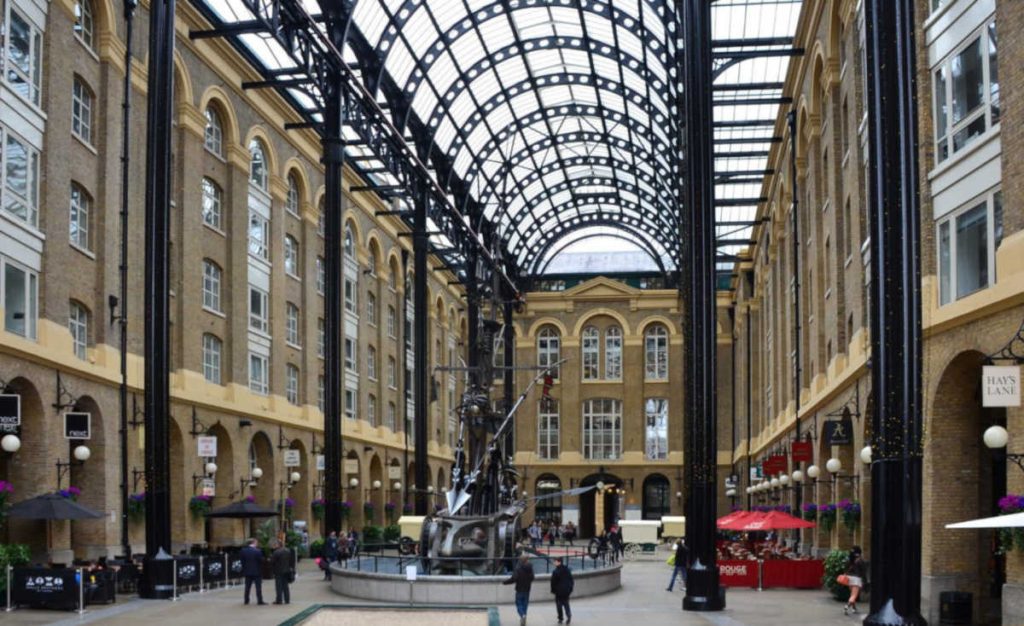- On July 9, 2020
- In Places
- Tags: Architects, Buildings
The Larder of London: Hay’s Galleria
 One thing that people flock to London for is our wide range of upmarket shops and stylish places to eat. As a guide, I’m always being asked which places I’d personally recommend, so today I thought we’d take a walk through one of my absolute favourites. For a combination of gorgeous surroundings, fascinating history and modern shops and places to eat, I’d say Hay’s Galleria must be near the top of the list.
One thing that people flock to London for is our wide range of upmarket shops and stylish places to eat. As a guide, I’m always being asked which places I’d personally recommend, so today I thought we’d take a walk through one of my absolute favourites. For a combination of gorgeous surroundings, fascinating history and modern shops and places to eat, I’d say Hay’s Galleria must be near the top of the list.
Located right on the river, Hay’s Galleria was once known as Hay’s Wharf. It’s named after an early owner, the merchant Alexander Hay who bought the property in 1651 as one of London’s many brewhouses. Near the start of the Victorian period the lease on what would become the Wharf passed to a John Humphrey Jnr who converted it into an enclosed dock and warehouse, renaming Hay’s Wharf in commemoration of the original owner.
During the 1800’s, Hay’s Wharf became a major centre for the import of goods, particularly the tea that is so closely associated with the era, from around the empire and even further afield. At the height of its use as a working wharf, it’s estimated that 80% of all the dry goods being imported into the city passed through this one dock- earning it the nickname ‘London’s Larder’.
In June 1861, disaster struck- the Great Fire of Southwark destroyed the wharf, along with much of the surrounding docklands. It was rebuilt and continued to be a working wharf, despite being badly bombed during the Blitz of 1940, right up until the forces of modernisation meant that shipping now needed deeper water berths and it closed as a commercial dock in 1970.
During the 1980’s a huge wave of urban regeneration swept the Thames Corridor and surrounding docklands, turning it into the fashionable, modern commercial area we see today. St Martian’s Property Corporation – the real estate arm of the government of Kuwait- bought most of the area, including Hay’s Wharf, and set to work regenerating.
The dock gates were shut for the last time and the wharf was paved over. The warehouses were regenerated into spaces for offices, shops and homes and a spectacular glass roof, reminiscent of an Italian galleria, was installed over the space, completing the rebirth into the fashionable area we see today. In 1987, the transformation from Hay’s Wharf to Hay’s Galleria was complete and it became the first new attraction of the period to open its doors to the public in the re-imagined area south of the river.
Perhaps the most striking thing about the reborn Galleria was designed by sculptor David Kemp. This takes the form of a 60ft (18.24m) moving bronze boat sculpture in the middle of a fountain at the Galleria’s centre. Entitled The Navigators this serves as both a breath taking centrepiece and as a nod to the shipping history of the area.
Given the views that Hay’s Galleria commands over the river, it’s hardly surprising that it’s become a favourite of visitors and residents alike since it’s reopening.
If you’d like to explore this slice of London’s merchant history and spend some time browsing the shops and traditional market barrows and be pointed in the direction of the best things to eat in the area, tours can be arranged by contacting through my website .